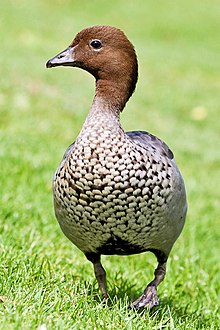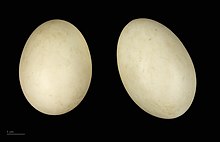Australian wood duck
| Australian wood duck | |
|---|---|

| |
| Adult female | |

| |
| Adult male | |
| Scientific classification | |
| Kingdom: | Animalia |
| Phylum: | Chordata |
| Class: | Aves |
| Order: | Anseriformes |
| Family: | Anatidae |
| Genus: | Chenonetta |
| Species: | C. jubata
|
| Binomial name | |
| Chenonetta jubata (Latham, 1801)
| |

| |
| Range in red | |
The Australian wood duck, maned duck or maned goose (Chenonetta jubata) is a dabbling duck found throughout much of Australia. It is the only living species in the genus Chenonetta. Traditionally placed in the subfamily Anatinae (dabbling ducks), it might belong to the subfamily Tadorninae (shelducks);[2] the ringed teal may be its closest living relative.[3]
Taxonomy[]
The Australian wood duck was first described by the English ornithologist John Latham in 1801 under the binomial name Anas jubata.[4]
The flightless New Zealand species Chenonetta finschi (Finsch's duck) which was formerly believed to constitute a monotypic genus (Euryanas) has been determined to belong to Chenonetta.[5] It became extinct before scientists could properly survey the New Zealand avifauna, but possibly as late as 1870 (based on a report of a flightless goose caught in Opotiki.[6])
Etymology[]
Chenonetta: Greek: χην khēn, χηνος khēnos “goose”; νηττα nētta “duck”.[7]
jubata: Latin: iubatus “maned, crested”, from iuba “mane, crest”[8]
Description[]
This 45–51 cm duck looks like a small goose, and mostly feeds by grazing in flocks.
The male is grey with a dark brown head and mottled breast. The female has white stripes above and below the eye and mottled underparts. Both sexes have grey wings with black primaries and a white speculum. Juveniles are similar to adult females, but lighter and with a more streaky breast.
Distribution and habitat[]
The Australian wood duck is widespread in Australia, including Tasmania. The Australian wood duck is found in grasslands, open woodlands, wetlands, flooded pastures and along the coast in inlets and bays. It is also common on farmland with dams, as well as around rice fields, sewage ponds and in urban parks. It will often be found around deeper lakes that may be unsuitable for other waterbirds' foraging, as it prefers to forage on land. It has been recorded as a vagrant in New Zealand, although in 2015 and 2016 a pair successfully bred there.[9]
Behaviour[]
Call[]
The most common call is a loud, rising croaky gnow sound by the females,[10] and the male call is the same except smoother, shorter and higher than the females. Staccato chattering is also present in flocks.[10]
Protection[]
Australian wood duck is widespread in its range. This species has benefited from agriculture developments, with creation of dams and pools. It is classified as a game bird, and killed by licensed hunters. This species is not threatened, and numbers are stable.
Reproduction[]

Australian wood duck nests in cavities in trees or in nest-boxes above or near water. Nests are made with a pile of down.
Breeding[]
This duck nests in a tree cavity laying 9–11 cream-white eggs, similar to the Mandarin ducks.[10] The female incubates them while the male stands guard. Once the ducklings are ready to leave the nest, the female flies to the ground and the duckling will leap to the ground and follow their parents. The males also secure their ducklings closely along with the females.
Feeding[]
The Australian wood duck eats grasses, grains, clover and other herbs, and occasionally, insects. It is rarely seen on open water, preferring to forage by dabbling in shallow water, or in grasslands and crops.
Similar species[]
The Australian wood duck can be distinguished from pygmy geese, Nettapus spp, which are smaller, have bold white face markings and are usually seen on water. Whistling ducks, Dendrocygna spp, have longer legs and necks, larger more duck-like bills and tend to walk more upright. When flying, the Australian wood duck is the only duck with white secondary feathers and dark wingtips.
Various views and plumages[]

Family in Australia

Profile view of female

Female swimming

Profile view of male

Ducklings in Kings Park, Western Australia

Family in Queensland

Duckling

Male at Belair National Park, South Australia
Males grazing at Belair National Park, South Australia

Male near Rankin Springs, New South Wales, Australia

Female near Rankin Springs, New South Wales, Australia
References[]
- ^ BirdLife International (2016). "Chenonetta jubata". IUCN Red List of Threatened Species. 2016: e.T22680111A92844188. doi:10.2305/IUCN.UK.2016-3.RLTS.T22680111A92844188.en. Retrieved 12 November 2021.
- ^ Sraml, M.; Christidis, L.; Easteal, S.; Horn, P.; Collet, C. (1996). "Molecular Relationships Within Australasian Waterfowl (Anseriformes)". Australian Journal of Zoology. 44 (1): 47–58. doi:10.1071/ZO9960047.
- ^ Johnson, Kevin P; Sorenson, Michael D (July 1999). "Phylogeny and Biogeography of Dabbling Ducks (Genus: Anas): A Comparison of Molecular and Morphological Evidence" (PDF). The Auk. University of California Press on behalf of the American Ornithologists' Union. 116 (3): 792–805. doi:10.2307/4089339. JSTOR 4089339.
- ^ Latham, John (1801). Supplementum indicis ornithologici sive systematis ornithologiae (in Latin). London: Leigh & Sotheby. p. lxix.
- ^ Worthy, Trevor H.; Olson, Storrs L. (2002). "Relationships, adaptations, and habits of the extinct duck 'Euryanas' finschi" (PDF). Notornis. Ornithological Society of New Zealand. 49 (1): 1–17.
- ^ Tennyson, A; Martinson, P. (2006). Extinct Birds of New Zealand. Wellington: Te Papa Press. ISBN 978-0-909010-21-8.
- ^ Jobling, J.A. (2017). "Key to Scientific Names in Ornithology". In del Hoyo, J.; Elliott, A.; Sargatal, J.; Christie, D.A.; de Juana, E. (2018) (eds.). Handbook of the Birds of the World Alive. Barcelona: Lynx Edicions.
- ^ Jobling, J.A. (2017). "Key to Scientific Names in Ornithology". In del Hoyo, J.; Elliott, A.; Sargatal, J.; Christie, D.A.; de Juana, E. (2018) (eds.). Handbook of the Birds of the World Alive. Barcelona: Lynx Edicions.
- ^ "Australian Wood Ducks breed in Mapua, Tasman". Stuff.co.nz. Stuff.co.nz. Retrieved 14 January 2019.
- ^ a b c Pizzey, G. and Knight, F. (1997). Field Guide to the Birds of Australia. Angus and Robertson, Sydney.
- Madge, Steve & Burn, Hilary (1987): Wildfowl : an identification guide to the ducks, geese and swans of the world. Christopher Helm, London. ISBN 0-7470-2201-1
Marchant, S. and Higgins, P.J. (eds). 1993. Handbook of Australian, New Zealand and Antarctic Birds. Vol 1B (Ratites to Ducks), Oxford University Press, Sydney.
Simpson, K and Day, N. (1999). Field guide to the birds of Australia, 6th Edition. Penguin Books, Australia.
Handbook of the Birds of the World vol 1 by Josep del Hoyo-Andrew Elliot-Jordi Sargatal - Lynx Edicions - ISBN 84-87334-10-5
– de Steve Madge - Delachaux et Niestlé - ISBN 2-603-01376-9
External links[]
![]() Media related to Chenonetta jubata at Wikimedia Commons
Media related to Chenonetta jubata at Wikimedia Commons
| Wikispecies has information related to Chenonetta jubata. |
- IUCN Red List least concern species
- Chenonetta
- Tadorninae
- Ducks
- Endemic birds of Australia
- Birds described in 1801
- Taxa named by John Latham (ornithologist)











